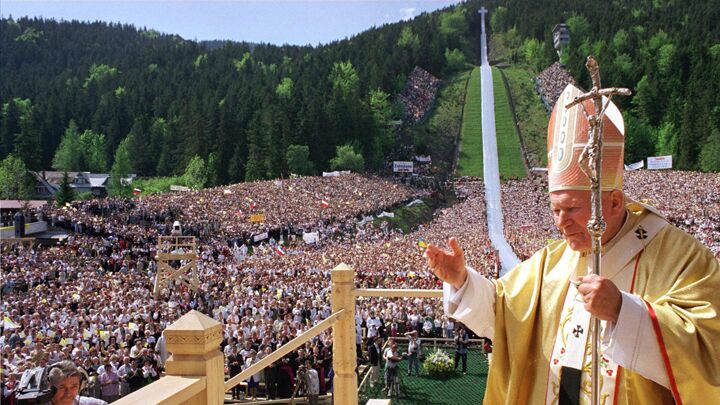
John Paul II Months From Sainthood
The path was cleared on Tuesday for former pope John Paul ii to be declared a saint when the Vatican attributed a second miracle to him. The church’s board of theologians of the Congregation for the Causes of Saints hasn’t disclosed the nature of the miracle, but unnamed inside sources say the late pope worked it after his death, and that it will “amaze the world” when the account is made public sometime in the next few weeks.
The sainthood process for a pope normally takes decades or even centuries, but John Paul ii’s successor, Benedict xvi, fast-tracked it for the late pontiff. Protestant churches had been swept into an unprecedented fervor of papal adulation at the time of John Paul ii’s death, and Benedict wanted to capitalize on the euphoria.
The healing of a French nun from Parkinson’s disease was declared as John Paul ii’s first miracle. It led to his beatification on May 1, 2011, by Benedict xvi. Reports say his second miracle took place on the very day of that beatification—several years after his death—and involved a Costa Rican woman’s “extraordinary healing” from severe brain injury after she and members of her family started praying to the dead pope.
With the two certified miracles now attributed to him, John Paul ii is just a few blessings away from sainthood. “The proclamation of his sainthood needs only the approval of the commission of cardinals and bishops and the final signature of Pope Francis,” Italian news agency ansa reported on Tuesday.
John Paul ii is expected to be formally made a saint on October 20. Since only five popes in the last 1,000 years have been named as saints, it will be a landmark event for Catholics and Christians under the Vatican’s sway
A Pope of Unification
John Paul ii was no ordinary pope. Karol Wojtyla was the youngest pontiff in 125 years, the first non-Italian pope in 455 years, and, having visited 120 nations during his papacy, the most traveled pope in history.
John Paul ii injected a new vitality into the Vatican that spilled the banks of Catholicism to enchant the whole Christian world. He rapidly became the most accessible pope of recent centuries, enjoying meals with factory workers, walking into crowds to embrace his devotees and even going snow skiing with friends. He survived an assassination attempt in 1981, and then forgave the Turkish man who had shot him.
John Paul ii brought Latin America back to its Catholic roots. He began turning secular France back to the Catholic Church. He took vital steps to eliminate liberalism from the church. And, by the time of his death, Anglicans and Catholics were taking such unprecedented strides toward unification that one Guardian headline said, “It’s as if the Reformation had never happened.”
John Paul ii was also the primary catalyst for change in Europe that reunited east with west. This led to the establishment of the eastern leg of the modern “Holy” Roman Empire—a key geopolitical event that had been foretold almost 2,500 years earlier in the writings of Daniel the prophet (see Daniel 2:33, 40-43, and read our free booklet on the topic to understand).
At the end of the Second World War, Europe was deeply divided between capitalist west and Communist east. In June of 1979, the Soviet grip on Eastern Europe appeared to be as tenacious as ever. But the windows of dingy, Stalin-era apartments in Warsaw, Poland, were adorned with festive shrines to welcome Pope John Paul ii. He was visiting his home country. During this pilgrimage the pope ignited a nonviolent revolution, which caused the Polish Solidarity movement to push against Communist forces. The momentum eventually toppled the Berlin Wall and routed Communist influence in Eastern Europe. The landmark event paved the way for many former Eastern Bloc nations (Poland, Romania, Bulgaria, Czech Republic, Estonia, Hungary, Latvia, Lithuania and Slovakia) to join the European Union.
For all these reasons and more, John Paul ii was a crowd-pleasing superstar. At his funeral, great masses of mourners chanted “Santo Subito!,” which means “Sainthood Now!” Now, just eight years on, his devotees are set to get their wish.
Great Works From the Grave?
Reports of miracles accomplished posthumously—like the late pope’s alleged healing of the Costa Rican woman—are common in the Catholic records. But the Holy Bible makes plain that when a person is dead, he or she is utterly inactive. “[T]he dead know not any thing. … There is no work, nor device, nor knowledge, nor wisdom, in the grave” (Ecclesiastes 9:5, 10). Only at the time of the resurrections—at the end of the age of men ruling of over men—will any person who has died again be capable of any consciousness or action (Revelation 20).
Despite the reports, we can be sure that the dead Polish man is not working miracles or doing anything else from inside his grave. Yet, because his successors are shrewdly harnessing the great euphoria of papal adulation that he generated during his papacy and thrusting him into sainthood with unprecedented speed, John Paul ii might indirectly accomplish more for the Roman Catholic Church in death than he did even in life.
John Paul’s funeral was a mass media event with an estimated 2 billion television viewers. One and a half million turned out in Rome for his beatification, with untold thousands more celebrating around the world. His canonization ceremony this fall could push this religious fervor to new heights, and be a great boost to his successors’ power. For more information about the way Pope John Paul ii laid the foundation for the Catholic Church’s rise to dominance, read our articles “Karol Wojtyla: How He Set the Stage” and “The Dark Side of the Pope’s Funeral.”
